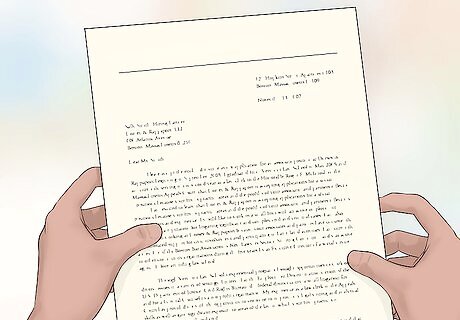
views
X
Research source
In order to defend against the charge, you need to analyze the crimes charged in the indictment and then draft an opposition motion. File your motion with the court clerk.
Analyzing the Defendant’s Motion

Read the defendant’s motion to dismiss. If you are a federal prosecutor, then the defendant filed a Motion to Dismiss pursuant to Rule 12(b)(3)(B)(ii). If you are a state prosecutor, then the defendant filed the motion pursuant to your state rule. You should read the motion as soon as you get it. Identify the counts that the defendant believes are multiplicitous.

Analyze the crimes charged. There is no easy way to tell whether an indictment suffers from multiplicity. One test is to compare the two counts and check whether either requires proof of an element that the other lacks. If so, then the counts are probably not multiplicitous. For example, you can charge a defendant with both “misapplication of funds” and “false entries.” False entry requires proof of an element (i.e., a false entry) which is missing from misapplication of funds. Accordingly, an indictment is not multiplicitous for charging both crimes.

Look at the legislative history. You also must look at the legislative intent when determining multiplicity. For example, Congress or the state legislature could intend for punishment to be cumulative even if the two counts are the same. Because the court focuses on Congressional intent, clear intent of imposing cumulative punishment cuts against finding multiplicity. Furthermore, even where the offenses have different elements and are not the same, the legislature might have clearly intended that only one punishment be administered. Probably the easiest way to research legislative history is by reading court opinions discussing the history of each criminal provision you have charged. Try to find whether the legislative intent is clear either way.
Drafting a Motion in Opposition

Find helpful court opinions. Perform legal research to find helpful cases from the Supreme Court or the Court of Appeals. Look for precedent where the Court held that the two offenses identified by the defendant were not multiplicitous.

Format your motion. You draft a Motion in Opposition like any other motion filed in a case. It should be typed up using the same font size and style. Also insert the caption information at the top. You should title the motion “Government’s Opposition to Defendant’s Motion to Dismiss the Indictment as Multiplicitous” or something similar.

Argue that the indictment doesn’t suffer from multiplicity. Remember to support your arguments with citations to supporting cases. If this is a novel fact pattern, then find a case that is somewhat similar. You should briefly summarize the test for multiplicity for the judge: “An indictment is multiplicitous and violates the double jeopardy clause of the Fifth Amendment only if it charges a single “offense” in more than one count. As the Supreme Court held in Blockburger v. United States, 284 U.S. 299, 304 (1932), multiple counts do not charge the same offense where each count ‘requires proof of an additional fact which the other does not.’” Then show how the two counts require proof of an additional element. Also discuss legislative history if it is helpful. Remember that it is helpful to you as a prosecutor even if the legislative history is unclear about whether Congress intended to allow multiple prosecutions. Cite the case Albernaz v. United States, 450 U.S. 333, 342-343 (1981) for the proposition that “if anything is to be presumed from the congressional silence on this point, it is that Congress was aware of the Blockburger rule and legislated with it in mind.”

Argue that the counts should be merged later. Even if two or more counts are multiplicitous, you can still argue that the proper remedy isn’t to dismiss one before trial. Instead, you can cite the case United States v. Blyden, 930 F.2d 323 (3d Cir. 1991) for the proposition that the proper remedy is to merge the multiplicitous counts at the time of sentencing or to dismiss one prior to sentencing. Some judges have found this argument persuasive. If you are in state court, then check to see if your state’s Supreme Court or an appellate court states the same thing.

Provide notice to the defendant. You must provide notice to the other side of every motion you file. If the defendant has an attorney, then be sure to send notice to the defendant’s attorney. Generally, you and defense counsel can decide ahead of time how you will serve notice to each other. For example, you could agree to fax each other a copy of your motions. Alternately, you could mail a copy.

File the motion. You might need to show the motion to a supervisor before filing. Once it is ready to go, make a copy for your records and file with the court clerk.
Arguing the Motion

Observe a motion hearing. If you’ve never argued before the judge before, then you will want to familiarize yourself with him or her. If possible, sit in on a motion hearing. Pay attention to what kinds of questions the judge asks and how much time he or she gives parties to argue. Talk to people in your office who have argued before the judge before. Get whatever helpful hints you can.

Listen to the defendant. As the person bringing the motion to dismiss, the defendant will go first. You should stand quietly and listen to the argument. If the defendant is representing him or herself pro se, then they might not make strong arguments. Don’t laugh or respond in any way, even if the defendant is making little sense. Take notes. In particular, note what the judge is interested in. If the judge is focused on a particular issue, then be sure to lead off with that when you get a chance to speak.

Make your argument. When it is your turn to speak, lead off with your strongest argument. You should also briefly point out what is wrong with the defendant’s argument. Remember not to stray outside the boundaries of the motion. The judge might ask specific questions about the facts or the law. You should have reread all motions and case law before the hearing. If you are afraid that you will forget case names, then you should write them out on the back of a manila folder so that you can briefly look down and find the name of the case. On your folder, include a very brief description of the case so that you can identify it.

Select which count to drop. The judge will likely decide all pretrial motions before trial. If you lose the motion, then the judge will order you to drop one of the multiple counts. You should think strategically about which one you want to drop. The multiplicitous counts may carry the same sentence, in which case it might not matter which one you drop. However, one count might carry a greater punishment. Or, one of the counts might be easier to prove to the jury. Talk with a supervisor or colleague about which count to drop.




















Comments
0 comment